Convair B-58 Hustler
The Convair B-58 Hustler, designed and produced by American aircraft manufacturer Convair, was the first operational bomber capable of Mach 2 flight.[2]
| B-58 Hustler | |
|---|---|
.jpg) | |
| Convair B-58 of the United States Air Force | |
| Role | Supersonic strategic bomber |
| National origin | United States |
| Manufacturer | Convair |
| First flight | 11 November 1956 |
| Introduction | 15 March 1960 |
| Retired | 31 January 1970 |
| Status | Retired |
| Primary user | United States Air Force |
| Number built | 116 |
| Unit cost | |
| Developed into | Convair Model 58-9 |
The B-58 was developed during the 1950s for the United States Air Force's (USAF) Strategic Air Command (SAC). To achieve the high speeds desired, Convair designed it around a large delta wing, which was also used by contemporary fighters such as the Convair F-102. It was powered by four General Electric J79 engines in underwing pods. It had no bomb bay; it carried a single nuclear weapon plus fuel in a combination bomb/fuel pod underneath the fuselage. Later, four external hardpoints were added, enabling it to carry up to five weapons.
The B-58 entered service in March 1960, and was operated for a decade by two SAC bomb wings: the 43d Bombardment Wing and the 305th Bombardment Wing.[3] It was considered a difficult aircraft to fly, imposing a high workload upon its three-man crews. Designed to replace the Boeing B-47 Stratojet strategic bomber, the B-58 became notorious for its sonic boom, which was often heard on the ground by the public as it passed overhead in supersonic flight.[4]
The B-58 was originally intended to fly at high altitudes and supersonic speeds to avoid Soviet interceptors. But with the Soviet introduction of high-altitude surface-to-air missiles, the B-58 was forced to adopt a low-level-penetration role that severely limited its range and strategic value. It was never used to deliver conventional bombs. The B-58 was substantially more expensive to operate than other bombers, such as the Boeing B-52 Stratofortress, and required more frequent aerial refueling. The B-58 also suffered from a high rate of accidental losses. All of this led to a relatively brief operational career of ten years. The B-58 was succeeded in its role by the smaller, swing-wing FB-111A.[5]
Development
Origins
The genesis of the B-58 was the Generalized Bomber Study (GEBO II) issued in February 1949 by the Air Research and Development Command (ARDC) at Wright-Patterson AFB, Ohio, for the development of a supersonic, long-range, manned bomber aircraft. Specifically, ARDC sought the best attainable numeric data, challenging the industry to devise their own solutions to attain the stated goal.[6] Work on the proposed bomber's design was to begin less than two years after sustained supersonic flight had been achieved.[7] According to aviation authors Bill Gunston and Peter Gilchrist, while some military officials were keenly interested in the prospective use of supersonic bombers at this time, other figures held a more negative attitude towards such ambitions due to fundamental questions over propulsion systems and material science involved in supersonic operations, as well as the very high fuel consumption incurred over subsonic counterparts.[8]
Despite scepticism from some quarters, multiple contractors decided to submit bids for GEBO II, which was viewed as an influential step towards securing a future to a development contract; these included Boeing, Convair, Curtiss, Douglas, Martin and North American Aviation. The majority of submissions were relatively straightforward and unambitious, as well as typically involving considerable expense.[6] Convair, which had built the XF-92A and other delta-wing fighters, initially looked at swept and semi-delta configurations, then settled on the delta wing planform, which offered good internal volume for support systems and fuel; it also provided low wing loading (for airframe size), permitting supersonic flight in the mid-stratosphere at 50,000 to 70,000 ft (15,000 to 21,000 m).[7] Most of the configurations studied involved matching said delta wing to a relatively slender fuselage, which housed a crew of two and was powered by a pair of jet engines.[6]
The initial Convair proposal, coded FZP-110, was a radical two-place, delta wing bomber design powered by an arrangement of three General Electric J53 turbojet engines. The performance estimates included a 1,000 mph (1,600 km/h) speed and a 3,000-mile (4,800 km) range.[7] A key feature of the design was to house consumables, both the weaponry and the majority of the fuel, within a large external pod, which enabled a reduction in the size of the aircraft. In January 1951, Convair submitted the FZP-110 proposal, this being received later than the majority of competing bids.[6] During December 1951, a revised FZP-016 proposal was submitted, which deleted the third engine on the tail, increased the remaining two engines' thrust output, and added a third crew member for operating defensive systems.[6]
Selection
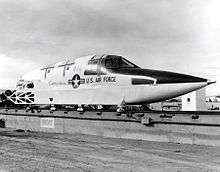
_061101-F-1234P-016.jpg)
The Air Force chose Boeing's MX-1712 and Convair MX-1626 design studies to proceed to a Phase 1 study. It was during this phase of development that Convair decided to take advantage of recent developments made by General Electric, replacing the two large J53 engines with four smaller J79s, which had been determined to be more optimal for supersonic flight.[9] The recently formulated area rule was also applied to the design, resulting in aerodynamic re-profiling of the aircraft, making its fuselage even more slender. Having been refined as such, Convair redesignated their renewed submission MX-1964.[10]
In August 1952, Convair's design was determined to be the superior;[11] According to Gunston and Gilchrist, Boeing's submission was viewed as being equally good, but that company's securing of a separate contract to produce the Boeing B-52 Stratofortress had undoubtably influenced decision makers in their selection for this competition.[10] Accordingly, in December 1952, it was selected to meet the newly proposed SAB-51 (Supersonic Aircraft Bomber) and SAR-51 (Supersonic Aircraft Reconnaissance), the first General Operational Requirement (GOR) worldwide for supersonic bombers. In February 1953, the Air Force issued a contract to develop Convair's design, which had been formally designated B-58 on 10 December 1952.[12][13]
The B-58 programme, unlike preceding military aircraft, was organised in a fashion now recognised as being the first weapon system contract.[14] Under this arrangement, Convair acted as the prime contractor, responsible for the satisfactory delivery of all elements relating the programme, not only the aircraft itself. As such, Convair had to devise or subcontract other entities to provide everything associated with the aircraft's operation, from the engines to training manuals, spare components, and software, in excess of one million items.[14] Early on, the contract was modified, calling for the production of a pair of XB-58 prototypes, 11 YB-58A pre-production aircraft, and 31 mission pods; these mission pods included a free-fall bomb pod, a rocket-propelled controllable bomb pod, a reconnaissance pod, and an electronic reconnaissance pod.[14]
Into flight
The first prototype, serial number 55-660, was rolled out on 31 August 1956.[15] The programme has been performed with a high level of security; prior to the roll out, no unauthorised individual had knowledge of its shape or basic configuration.[16] On 11 November 1956, the maiden flight of the type was performed; the prototype exceeded Mach 1 for the first time on 30 December of that year.[17] A difficult and protracted flight test program involving 30 aircraft continued until April 1959.[18] A total of 116 B-58s were produced: 30 trial aircraft and 86 production B-58A models. Most of the trial aircraft were later upgraded to operational standard; eight were equipped as TB-58A training aircraft.[19]
Convair sought to develop the B-58 further, various variants and derivatives were proposed for both military and civil applications.[19] Most would never go beyond the drawing board, a sizable proportion having at one point been ordered prior to a decision to terminate multiple contracts; the B-58B, B-58C, B-58D, and B-58E variants were all terminated prior to any production aircraft being completed. During the late 1960s, some refinements to the existing fleet were developed and introduced, such as slender bomb racks (known as Multiple Weapons Capability) and additional pods.[19] The final B-58 was delivered in October 1962.[18][20]
Design
Overview
The Convair B-58 Hustler was a high speed strategic bomber, capable of attaining routinely Mach 2 at altitude. It incorporated a large delta wing with a leading-edge sweep of 60° and was powered by an arrangement of four General Electric J79-GE-1 turbojet engines. Although its sizable wing generated relatively low wing loading, it proved to be surprisingly well suited for low-altitude, high-speed flight. To protect against the heat generated while cruising at Mach 2, the crew compartment, the wheel wells and electronics bay were pressurized and air conditioned. The B-58 was one of the first extensive applications of aluminum honeycomb panels, which bonded outer and inner aluminum skins to a honeycomb of aluminum or fiberglass.[21]
Various features of the B-58 were considered to be record-breaking, according to Gunston and Gilchrist.[22] The structure itself made up 13.8 per cent of the aircraft's gross weight, an exceptionally low figure for the era, while the wing was considered to be extremely thin as well. Several key features of the engine, including the nacelle and the inlet, were unlike any existing aircraft, having been devised from guidance by aerodynamicists.[22] Specifically, the inlets used moving conical spikes, being fully aft on the ground and at low speeds to maximise air intake, then driven forward while being flown at high speeds to minimise the annular gap. This movement was automatically controlled, but significant noise and asymmetric thrust would be generated in the event of a single inlet malfunctioning.[23]
Crew provisions
The B-58 was operated by a crew of three: pilot, bombardier/navigator, and defensive systems operator. They were seated in separated tandem cockpits. The pilot's cockpit, which was provided with very deep windows, was considered to be mostly conventional for a large multi-engine aircraft.[24][23] The defensive systems operator was provisioned with a complex arrangement of different systems, which Gunston and Gilchrist describe as being the most complicated of any aircraft of the era. The space allocated to the crew, despite being roughly half of the fuselage's internal volume, was typically considered to be cramped and claustrophobic.[25]
Later versions of the B-58 provided each crew member with a novel ejection capsule that could eject at an altitude of 70,000 ft (21,000 m) at speeds up to Mach 2. Unlike standard ejection seats of the period, a protective clamshell would enclose the seat and the control stick with an attached oxygen cylinder, allowing the pilot to continue to fly even "turtled up" and ready for immediate egress. The capsule was buoyant; the crewmember could open the clamshell, and use it as a life raft.[16][26] Unusually, the ejection system was tested with live bears and chimpanzees;[27] it was qualified for use during 1963.[16] The XB-70 would use a similar system with capsules of a different design.
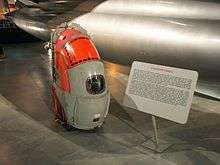
The electronic controls were ambitious and advanced for the day. The navigator and DSO's cockpits featured wraparound dashboards with warning lights and buttons, and automatic voice messages and warnings from a tape system were audible through the helmet sets. Research during the era of all-male combat aircraft assignments revealed that a woman's voice was more likely to gain the attention of young men in distracting situations. Nortronics Division of Northrop Corporation selected actress and singer Joan Elms to record the automated voice warnings. To those flying the B-58, the voice was known as "Sexy Sally."[28][29]
Adverse flight characteristics
While the B-58's performance and design were exceptional for the era, it was not an easy aircraft to fly. This was caused by the 60° leading edge sweepback of its wing and was inherent in these types of delta wing platforms. It required a much higher angle of attack than a conventional aircraft, up to 9.4° at Mach 0.5 at low altitudes. If the angle of attack was too high, in excess of 17°, the bomber could pitch up and enter a spin. Several factors could prevent a successful recovery: if the pilot applied elevon, if the center of gravity was not correctly positioned, or if the spin occurred below 15,000 feet (4,600 metres), recovery might not be possible. The B-58 also possessed unconventional stall characteristics; if the nose was elevated, the bomber maintained forward motion without pitching down. Unless large amounts of power were applied, the descent rate increased rapidly.[30] Another problem pilots faced was called "fuel stacking", taking place whenever the B-58 accelerated or decelerated. It was caused by fuel movement within the tanks, which led to sudden changes in the aircraft's center of gravity. This could cause the B-58 to abruptly pitch or bank, potentially resulting in a loss of control.[31]
The aircraft had unusual takeoff requirements, with a 14° angle of attack needed for the rotation at about 203.5 knots (376.9 km/h; 234.2 mph) for a 150,000-pound (68,000 kg) combat weight.[32] This poor takeoff performance was evident with the high landing speed, necessitating a drogue parachute for braking, which was also required for B-47 and B-52 aircraft. To accommodate the high landing speed, the specially configured landing gear had to handle excessive conditions, both the inflation pressure and wheel rpm were far greater than prior units in order to cope.[22]
Weapons systems
The Sperry AN/ASQ-42 bombing/navigation system combined a sophisticated inertial navigation system with the KS-39 Star tracker (astro-inertial navigation system) to provide heading reference, the AN/APN-113 Doppler radar to provide ground speed and windspeed data, a search radar to provide range data for bomb release and trajectory, and a radar altimeter.[33] The AN/ASQ-42 was estimated to be 10 times more accurate than any previous bombing/navigation system.[33]
Defensive armament consisted of a single 20 mm (0.79 in) T-171E-3 rotary cannon with 1,200 rounds of ammunition in a radar-aimed tail barbette.[33][34] It was remotely controlled through the Emerson MD-7 automated radar fire-control system only requiring the DSO to lock-on a selected target blip on his scope and then fire the gun. The system computed aiming, velocity or heading differential, and range compensation.[33] Offensive armament typically consisted of a single nuclear weapon, along with fuel tanks, in a streamlined MB-1C pod under the fuselage. Incurable difficulties with fuel leakage resulted in the replacement of the MB-1C with the TCP (Two Component Pod), which placed the nuclear weapon in an upper section while the lower fuel component could be independently jettisoned.[35] This had the added benefit of allowing the pilot to "clean up" the aircraft for fuel efficiency or in case of emergency, while still retaining the (somewhat) slimmer weapon.
From 1961 to 1963, the B-58 was retrofitted with two tandem stub pylons under each wing root, adjacent to the centreline pod,[36] for B43 or B61 nuclear weapons for a total of five nuclear weapons per aircraft. Although the USAF looked at using the B-58 for conventional strikes, it was never equipped for carrying or dropping conventional bombs. A photo reconnaissance pod, the LA-331, was also fielded. Several other specialized pods for ECM or an early cruise missile were considered, but not adopted. The late-1950s High Virgo air-launched ballistic missile was designed to be launched from the B-58; a Hustler carried out four test launches to determine ballistic missile and anti-satellite weapon system capability.[37][38]
Operational history
Introduction

On 1 August 1960, the B-58 was declared operational, nine months after the delivery of the first aircraft to the Air Force.[19] One month later, a single B-58 participated in the annual SAC Combat Competition at Bergstrom; it proved itself to be superior to competing Boeing B-47 Stratojets and Boeing B-52 Stratofortresses, securing first place in both high-level and low-level radar bombing exercises.[19]
Crews were typically chosen from other strategic bomber squadrons. Due to some characteristics of delta-winged aircraft, new pilots used the Convair F-102 Delta Dagger as a conversion trainer, before moving to the TB-58A trainer.[39] The B-58 was found to be difficult to fly and its three-man crews were constantly busy, but its performance was exceptional. A lightly loaded Hustler would climb at nearly 46,000 ft/min (235 m/s).[40] In addition to its much smaller weapons load and more limited range than the B-52, the B-58 had been extremely expensive to acquire.
Excessive program expenditure
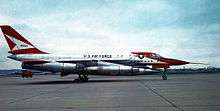
Through FY 1961, the total cost of the B-58 program was $3 billion ($20 billion in 2018 dollars).[41][42] A highly complex aircraft, it also required considerable maintenance, much of which required specialized equipment and ground personnel. For comparison, the average maintenance cost per flying hour for the B-47 was $361, for the B-52 it was $1,025 and for the B-58 it was $1,440.[43] The B-58 cost three times as much to operate as the B-52.[44] The cost of maintaining and operating the two operational B-58 wings (39 aircraft per wing) equaled that of six wings of B-52s (only 15 aircraft per wing). Because of the support costs of six wings vs only two wings, the actual cost per aircraft of the B-52s were $1.42 million per year vs $1.21 million per year for the B-58 (this figure included special detailed maintenance for the nose landing gear, which retracted in a complex fashion to avoid the center payload).[30]
Compounding these exorbitant costs, the B-58 had a high accident rate: 26 B-58 aircraft were lost in accidents, 22.4% of total production, more than half of the losses occurred during flight tests. The SAC senior leadership had been doubtful about the aircraft type from the beginning, although its crews eventually became enthusiastic about the aircraft. General Curtis LeMay was never satisfied with the bomber, and after a flight in one declared that it was too small, far too expensive to maintain in combat readiness and required an excessive number of aerial refuelings to complete a mission.[45] Although the high altitude ferry range of the B-58 was better than that of the B-47s, the lack of forward basing resulted in a requirement for more KC-135 tanker support.[46][47]
Operational wings and retirement
Two SAC bomb wings operated the B-58 during its operational service: the 43d Bombardment Wing (which later transitioned to the 43rd Airlift Wing), based at Carswell AFB, Texas from 1960 to 1964, and Little Rock AFB, Arkansas from 1964 to 1970; and the 305th Bombardment Wing, based at Bunker Hill AFB (later Grissom AFB), Indiana from 1961 to 1970. The 305th also operated the B-58 combat crew training school (CCTS), the predecessor of the USAF's current formal training units (FTUs).
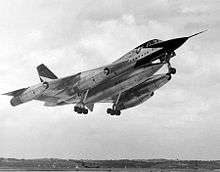
By the time the early problems had largely been resolved and SAC interest in the bomber had solidified, Secretary of Defense Robert McNamara decided that the B-58 was not a viable weapon system.[48] It was during the B-58's introduction that high-altitude Soviet surface-to-air missiles (SAM) became a threat, especially the SA-2 Guideline, a SAM system the Soviet Union extensively deployed. The "solution" to this problem was to fly at low altitudes, minimizing the radar line-of-sight and reducing exposure time.
Because of dense air at low altitudes, the B-58 could not fly at supersonic speeds and its moderate range was reduced further, negating the costly high-speed performance of the aircraft. Despite shortcomings, the type had its advocates within the service; according to Gunston and Gilchrist, when Secretary McNamara had requested proposals for a new manned Mach 2 bomber, General Thomas S. Power responded with a request for the B-58 to be put back into production.[49] In late 1965, McNamara ordered retirement of the B-58 by 1970; the principal reason given for this directive was the high sustainment cost for the fleet. On 29 October 1969, the Department of Defense announced that the type would be withdrawn from service on 31 January 1970.[49]
Despite efforts of some officials within the Air Force to secure a reprieve, the phaseout proceeded on schedule. The last B-58s were retired in January 1970, after which they were placed into storage with the Military Aircraft Storage and Disposition Center (MASDC) at Davis-Monthan Air Force Base. The fleet survived intact until 1977, at which point nearly all remaining aircraft were sold to Southwestern Alloys for disposal.[50][51] As a weapons system, the B-58 was replaced by the FB-111A. This aircraft was designed for low-altitude attack, to be more flexible with the carriage of conventional weapons, and less expensive to produce and maintain.
Since B-58 pilots were the only USAF pilots experienced in long-duration supersonic flight, several former Hustler crew members were selected by Colonel Douglas Nelson to fly the Lockheed SR-71 Blackbird at the start of that program.
Test aircraft
A number of B-58s were used for special trials. One was specially modified to test the Hughes radar system intended for the Lockheed YF-12 interceptor and the North American F-108 Rapier, which had an extended nose to accommodate the radar and was nicknamed "Snoopy" (see Aircraft on Display). Several improved (and usually enlarged) variants, named B-58B and B-58C by the manufacturer, were proposed but never built.
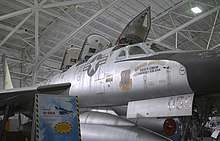
World records
The B-58 set 19 world speed records, including coast-to-coast records, and the longest supersonic flight in history. In 1963, it flew from Tokyo to London (via Alaska), a distance of 8,028 miles (12,920 km), with 5 aerial refuelings in 8 hours, 35 minutes, 20.4 seconds, averaging 938 miles per hour (1,510 kilometres per hour). As of 2016, this record still stands.[52][53] The aircraft was serving in an operational unit, and had not been modified in any way besides being washed and waxed. One of the goals of the flight was to push the limit of its new honeycomb construction technique. The speed of the flight was limited only by the speed at which they believed the honeycomb panels would delaminate, although one of the afterburners malfunctioned and the last hour of the flight was continued at subsonic speed. This reduced the average speed to roughly Mach 1.5, despite most of the flight being at Mach 2.[54][55] This B-58 was called "Greased Lightning" – the codename for the record attempt.
Some of the record winning aerospace trophies the B-58 won were the Bleriot trophy, the Thompson trophy, the Mackay trophy, the Bendix trophy and the Harmon trophy.[56][57]
Singer John Denver's father, Lieutenant Colonel Henry J. Deutschendorf, Sr., USAF, held several speed records as a B-58 pilot.[58]
Variants
- XB-58: Prototype; two built.
- YB-58A: Pre-production aircraft; 11 built.
- B-58A: Three-seat medium-range strategic bomber aircraft; 86 built.
- TB-58A: Training aircraft. Eight conversions from YB-58A.
- NB-58A: This designation was given to a YB-58A used to test the General Electric J93 engine, originally intended for the North American XB-70 Valkyrie Mach 3 bomber.
- RB-58A: Variant with ventral reconnaissance pod; 17 built.
- B-58B: Unbuilt. Larger and faster than the B-58A, this version would have had uprated J79-GE-9 engines, a longer fuselage for extra fuel capacity, canards, and the ability to carry conventional weapons.[31][59] A prototype B-58B was ordered (S/N 60-1109) and a total purchase of 185 envisioned, but the entire project was canceled before construction began, due to budgetary considerations.[60] The B variant was also planned to be the mothership for a Mach 4 parasite called the FISH, for First Invisible Super Hustler. That FISH had three ramjets that would be ignited at an altitude of at least 35,000 feet (11,000 metres) and speeds over Mach 2.[61] The Super Hustler would then drop from the B-58B, climb to 90,000 feet (27,000 metres), and accelerate to Mach 4.2 to complete its mission.[62][63]
- B-58C: Unbuilt. Proposed as a cheaper alternative to the XB-70, this enlarged version would have carried more fuel and 32,500 lbf (145 kN) J58 engines, the same ones used on the Lockheed SR-71. Design studies were conducted with two- and four-engine designs. Capable of carrying conventional weapons, the C model had an estimated top speed approaching Mach 3, a supercruise capability of about Mach 2, a service ceiling of about 70,000 ft (21,300 m), and a maximum range of 5,200 nautical miles (6,000 mi; 9,600 km). As enemy defenses against high-speed, high-altitude penetration bombers improved, the value of the B-58C diminished and the program was canceled in early 1961.[64]
- B-58D: Unbuilt. Proposed as an interceptor aircraft, taking advantage of its speed and high altitude performance.[19]
- B-58E: Unbuilt. Proposed as a multi-mission platform, to have been armed with numerous air-launched ballistic missiles (ALBM).[19]
- Convair Model 58-9: a proposed supersonic transport. First developed by Convair in 1961, it was intended to carry 58 passengers at speed in excess of Mach 2. Multiple revisions of this proposal was submitted to Congress as Convair's bid for the National Supersonic Transport program.[19]
Operators
- United States Air Force
- 43d Bombardment Wing – Carswell AFB, Texas (1960–1964); Little Rock AFB, Arkansas (1964–1970)
- 63d Bombardment Squadron, Medium
- 64th Bombardment Squadron, Medium
- 65th Bombardment Squadron, Medium
- 6592d Test Squadron
- 3958th Operational Test and Evaluation Squadron (1958–1960)
- 305th Bombardment Wing – Bunker Hill (later Grissom AFB), Indiana (1961–1970)
- Air Force Flight Test Center – Edwards AFB, California (1956–1958)
- 43d Bombardment Wing – Carswell AFB, Texas (1960–1964); Little Rock AFB, Arkansas (1964–1970)
Incidents
In September 1961, a B-58 on training flight from Carswell Air Force Base suffered a fire and failure of the left main gear. A chase aircraft was sent to examine the aircraft in flight. Through the night, eight sessions of aerial refuellings were conducted, using an improved technique, and once daylight broke a successful emergency landing was made at Edwards Air Force Base. The Air Force made a training film about the incident, including film of the landing.[65]
On 3 June 1961 B-58A 59-2451 Firefly crashed during the Paris Air Show, killing all three on board. The aircraft had earlier made the first supersonic transatlantic crossing between New York and Paris in less than 3 hours 20 minutes.[66]
On 15 June 1965, at the Paris Air Show, Lt. Colonel Charles D. Tubbs was killed and two other crewmen injured when their B-58 crashed. The aircraft landed short of the runway, struck the instrument approach beacons and burst into flames.[67]
Aircraft on display

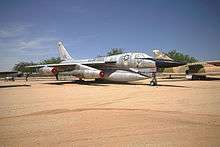
Today there are eight B-58 survivors:[68][69]
- TB-58A
- 55-0663 – Grissom Air Museum, Grissom Air Reserve Base (former Bunker Hill AFB / former Grissom AFB), Peru, Indiana. This is the oldest remaining aircraft and the fourth B-58 built.[70]
- 55-0668 – Little Rock Air Force Base in Jacksonville, Arkansas.[71]
- B-58A
- 55-0665 (Snoopy) – Edwards Air Force Base, California, 34.816163°N 117.863709°W. Built as a YB-58A, later redesignated B-58A. This aircraft sits derelict as a photo target on Edwards AFB's photo range.[72]
- 55-0666 – Built as a YB-58A, later redesignated B-58A. Under restoration at Castle Air Museum at the former Castle Air Force Base in Atwater, California. Formerly on display at Octave Chanute Aerospace Museum, Rantoul, Illinois.[73][74][75][76]
- 59-2437 (Firefly II) – Lackland AFB/Kelly Field Annex (former Kelly Air Force Base), San Antonio, Texas.[77]
- 59-2458 (Cowtown Hustler) – National Museum of the United States Air Force, Wright-Patterson Air Force Base, Dayton, Ohio. This aircraft flew from Los Angeles to New York City and back on 5 March 1962, setting three separate speed records, and earning the crew the Bendix Trophy and the Mackay Trophy for 1962. The aircraft was flown to the Museum on 1 March 1969. The aircraft is on display in the Museum's Cold War gallery.[78]
- 61-2059 (Greased Lightning) – Strategic Air Command & Aerospace Museum near Ashland, Nebraska. It averaged 938 nmph flying 8,028 nmi. from Tokyo to London in 8 hours and 35 minutes in October 1963.[79]
- 61-2080 – Pima Air & Space Museum, adjacent to Davis-Monthan Air Force Base, in Tucson, Arizona. It was the last B-58 to be delivered.[80]
Specifications (B-58A)
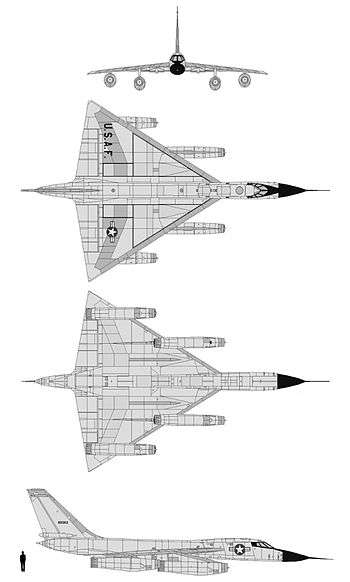


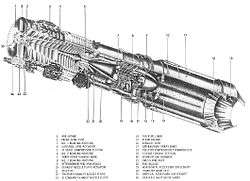
Data from Quest for Performance[81]
General characteristics
- Crew: Three
- Length: 96 ft 10 in (29.51 m) [82]
- Wingspan: 56 ft 9 in (17.30 m) [82]
- Height: 29 ft 11 in (9.12 m)
- Wing area: 1,542 sq ft (143.3 m2)
- Aspect ratio: 2.09
- Airfoil: root: NACA 0003.46; tip: NACA 0004.08[83]
- Empty weight: 55,560 lb (25,202 kg)
- Gross weight: 67,871 lb (30,786 kg)
- Max takeoff weight: 176,890 lb (80,236 kg)
- Zero-lift drag coefficient: CD0.0068
- Frontal area: 10.49 sq ft (0.975 m2)
- Powerplant: 4 × General Electric J79-GE-5A afterburning turbojet, 10,400 lbf (46 kN) thrust each dry, 15,000 lbf (67 kN) with afterburner
Performance
- Maximum speed: 1,146 kn (1,319 mph, 2,122 km/h) at 40,000 ft (12,000 m)[82]
- Maximum speed: Mach 2.0
- Cruise speed: 530 kn (610 mph, 980 km/h)
- Range: 4,100 nmi (4,700 mi, 7,600 km)
- Combat range: 1,740 nmi (2,000 mi, 3,220 km)
- Service ceiling: 63,400 ft (19,300 m)
- Rate of climb: 17,400 ft/min (88 m/s) at gross weight[84]
- Lift-to-drag: 11.3 (subsonic, "clean configuration")
- Wing loading: 44 lb/sq ft (210 kg/m2)
- Thrust/weight: 0.919
Armament
- Guns: 1× 20 mm T171 cannon[82]
- Bombs: 1× Mark 39 or B53 or 4× B43 or B61 nuclear bombs; maximum weapons load was 19,450 lb (8,820 kg)
Avionics
- AN/APB-2 Bombing radar[85]
- AN/APN-110 Doppler navigational radar[86] (part of Sperry AN/ASQ-42 Navigation & Bombing System)[87]
- AN/APN-170 Terrain-following radar[86]
- AN/APR-12 Radar warning receiver[88]
- Hughes Aircraft AN/APQ-69 podded Side looking airborne radar (mounted on RB-58A)[89]
- Goodyear AN/APS-73 podded synthetic aperture radar (mounted on RB-58A)[88]
Notable appearances in media
Jimmy Stewart, a bomber pilot during World War II and a brigadier general in the Air Force Reserve, appeared in the Air Force documentary film B-58 Champion of Champions. In the film, Stewart flew in the back seat of the B-58 on a typical low-altitude attack.[90]
In the film Fail Safe, the attack on Moscow is made by a squadron of "Vindicator" bombers, fictitious aircraft.[91] While exterior shots of the plane relied on footage of B-58s, interior shots depicted a three-man crew, similar to that of a conventional airliner, and distinct from the tandem seating on a real B-58.
See also
- CORDIC algorithm (a digital resolver for Convair's navigation computers CORDIC I and II)
- High Virgo
- Wagtail (missile)
Related development
Aircraft of comparable role, configuration and era
Related lists
References
Citations
- Knaack, Marcelle Size. Post-World War II Bombers, 1945–1973. Washington, DC: Office of Air Force History, 1988. ISBN 0-16-002260-6.
- Wilson 2000, p. 38.
- Martin, Douglas. "Robert H. Widmer, Designer of Military Aircraft, Dies at 95". The New York Times, 2 July 2011.
- "B-58's Sonic Boom Rattles Kentuckians". Chicago Daily Tribune, 19 December 1961. Retrieved: 2 November 2009.
- Morrison, David C. (February 1984). "The Weapons Tutorial: Air-Breathing Nuclear Delivery Systems". Bulletin of the Atomic Scientists. 40 (2): 34.
- Gunston and Gilchrist 1993, p. 173.
- Miller 1976, p. 24.
- Gunston and Gilchrist 1993, p. 172.
- Gunston and Gilchrist 1993, pp. 173-174.
- Gunston and Gilchrist 1993, p. 174.
- Miller 1985, p. 26.
- Miller 1985, p. 28.
- Gunston and Gilchrist 1993, p. 175.
- Gunston and Gilchrist 1993, pp. 174-175.
- Miller 1985, p. 39.
- Gunston and Gilchrist 1993, p. 177.
- Miller 1985, p. 42.
- Miller 1985, p. 54.
- Gunston and Gilchrist 1993, p. 178.
- "U.S. halts jet bomber production". Eugene Register-Guard. (Oregon). UPI. November 2, 1962. p. 4A.
- Loftin, Laurence K. Jr. "Quest for Performance: The Evolution of Modern Aircraft. Part II: The Jet Age. Chapter 12: Jet Bomber and Attack Aircraft. Two Pioneering Explorations." National Aeronautics & Space Administration, 2004. Retrieved: 1 December 2014.
- Gunston and Gilchrist 1993, pp. 175-176.
- Gunston and Gilchrist 1993, p. 176.
- Miller 1985, p. 94.
- Gunston and Gilchrist 1993, pp. 176-177.
- Force, United States Air (1 January 2008). Convair B-58 Hustler Pilot's Flight Operating Instructions. p. 107. ISBN 9780981652658.
- Miller 1985, pp. 53–54.
- "Voice warning systems message priority." palaamar.com. Retrieved: 14 September 2015.
- "Sexy Sally Sounds Off." San Francisco Examiner, 30 July 1966, reprinted in United States Naval Institute Proceedings, November 1966.
- Hall, R. Cargill. "The B-58 Bomber." Air University Review, Research Division, at the Albert F. Simpson Historical Research Center, Maxwell AFB, Alabama, November–December 1981. Retrieved: 14 February 2015.
- Slade 2012, p. 238.
- Force, United States Air; Usaf (2008-01-01). Convair B-58 Hustler Pilot's Flight Operating Instructions. ISBN 9780981652658.
- Miller 1985, p. 105.
- "Convair B-58 Hustler Strategic Bomber." AeroSpaceWeb.org, 2012. Retrieved: 12 December 2014.
- Miller 1985, p. 109.
- Hansen 1988, pp. 158, 161.
- "Designation systems." designation-systems.net. Retrieved: 8 December 2009.
- "B-58 Air Launched Ballistic Missile" – via www.youtube.com.
- Miller 1985, p. 62.
- Higham 1975, p. 31.
- Miller 1985, p. 48.
- Hall, R. Cargill. "To acquire strategic bombers – The case of the B-58 Hustler." Air University Review, Research Division, at the Albert F. Simpson Historical Research Center, Maxwell AFB, Alabama, Sept–Oct 1980. Retrieved: 15 February 2015.
- Converse 2012, p. 517.
- Miller 1985, p. 69.
- Adams 2009, p. 41.
- "B-58 Hustler United States Nuclear Forces." FAS (Federation of American Scientists), 29 May 1997. Retrieved: 15 February 2015.
- "B-58 final construction." GlobalSecurity, 2015. Retrieved: 15 February 2015.
- Sorenson 1995, p. 131.
- Gunston and Gilchrist 1993, p. 179.
- Miller 1985, p. 70.
- Veronico and Strong 2010, p. 112.
- QUALA MATOCHA. "Former Hillje man holds longest supersonic flight record after 50 years" El Campo Leader News, October 23, 2013. Accessed: December 15, 2013.
- Comstock, Charles. "The B-58's record flights." 456fis.org (456th Fighter Interceptor Squadron), Seymour Johnson Air Field North Carolina. Retrieved: 2 January 2015.
- Wayne Thomis, Aviation editor, Chicago Tribune. November 24, 1963.
- Haynes, Leland R. "B-58 Hustler records & 15,000 miles non-stop in the SR-71." wvi.com (SR-71 Blackbirds), 1996. Retrieved: 12 December 2014.
- website=b58hustlerassn.net "Trophies won and records set by the B-58." B-58 Hustler Association HomePage. Retrieved: 2 January 2015.
- Gunston and Gilchrist 1993, pp. 178-179.
- Tope, Jessica. "Pope Air Force Base Record Breaking Day." Pope Air Force Base, 12 January 2007. Retrieved: 5 September 2007.
- Goebel, Greg. "The General Dynamics B-58 & North American XB-70." AirVectors.net, 1 August 2014. Retrieved: 26 January 2015.
- "Factsheet: Convair B-58B." NationalMuseum.AF.mil (National Museum of the United States Air Force). Retrieved: 9 July 2017.
- "Convair Super Hustler, Fish & Kingfish." AeroSpaceWeb.org, 2012. Retrieved: 11 December 2014.
- Hehs, Eric. "Super Hustler, FISH, Kingfish, and Beyond (Part 1: Super Hustler)." CodeOneMagazine.com (Lockheed Martin Aeronautics Company), 15 March 2011. Retrieved: 11 December 2014.
- Burrows, William E. "The Real X-Jet." AirSpaceMag.com, 1 March 1999. Retrieved: 13 December 2014.
- "Factsheet: Convair B-58C Hustler." National Museum of the United States Air Force. Retrieved: 9 July 2017.
- Video on YouTube
- "Paris Show Visitors see last roll". The Times (55099). London. 5 June 1961. p. 11.
- "ASN Wikibase Occurrence # 154902". Aviation Safety Network. Retrieved 26 January 2020.
- "B-58 Aircraft History – serial numbers and summary." Archived 2014-12-22 at the Wayback Machine The B-58 Hustler Association. Retrieved: 4 December 2014.
- Brewer, Randy A. and Alex P. Brewer. "The B-58 Hustler Page – Surviving Inventory." Archived 2014-12-18 at Archive.today B-58.com, 2014. Retrieved: 18 December 2014.
- "B-58 Hustler/55-0663." Grissom Air Museum. Retrieved: 4 December 2012.
- "B-58 Hustler/55-0668." aerialvisuals.ca Retrieved: 4 June 2015.
- "B-58 Hustler/55-0665." aerialvisuals.ca Retrieved: 20 May 2013.
- "Vintage Fort Worth-built B-58 Bomber headed to California museum" Fort Worth Star Telegram Retrieved 18 December 2017
- "B-58 Hustler/55-0663." Castle Air Museum. Retrieved: 18 December 2017.
- "USAF Serial Number Search (55-666)". Retrieved 2018-02-14.
- "Glory of former base slowly dimming as another AF plane leaves". Rantoul Press. 2017-08-15.
- "B-58 Hustler/59-2437." aerialvisuals.ca Retrieved 4 June 2015.
- "B-58 Hustler/59-2458." National Museum of the USAF. Retrieved: 18 December 2017.
- "B-58 Hustler/61-2059." Strategic Air and Space Museum. Retrieved 18 December 2017.
- "B-58 Hustler/61-2080." Pima Air & Space Museum. Retrieved: 4 December 2012.
- Loftin, Laurence K. Jr. "SP-468: Quest for Performance: The Evolution of Modern Aircraft". NASA, Retrieved: 4 April 2006.
- Grant and Dailey 2007, p. 293.
- Lednicer, David. "The Incomplete Guide to Airfoil Usage". m-selig.ae.illinois.edu. Retrieved 16 April 2019.
- Gunston 1986, p. 162.
- "AN/APA to AN/APD – Equipment Listing." Designation-Systems.net. Retrieved: 3 July 2010.
- "AN/APN – Equipment Listing." Designation-Systems.net. Retrieved: 3 July 2010.
- "AN/ASQ – Equipment Listing." Designation-Systems.net. Retrieved: 3 July 2010.
- "AN/APR to AN/APS – Equipment Listing." Designation-Systems.net. Retrieved: 3 July 2010.
- "AN/APQ – Equipment Listing." Designation-Systems.net. Retrieved: 3 July 2010.
- "Convair B-58 Hustler, Champion of Champions." YouTube (United States Air Force), 3 December 2014.
- "The B-58 Hustler: America's Cold War Nuclear Bomber Blunder". The National Interest, 10 June 2016.
Bibliography
- Adams, Chris. Deterrence: An Enduring Strategy. New York: IUniverse, Inc., 2009 ISBN 978-1-44016-9786
- Convair B-58 Hustler Pilot's Flight Operating Instructions. Washington, D.C.: United States Air Force, 2008. ISBN 978-0-9816526-5-8.
- Converse, Elliott V. Rearming for the Cold War, 1945–1960 (History of Acquisition in the Department of Defense). Washington, D.C.: Office of the Secretary, Historical Office, 2012. ISBN 978-0-16091-132-3.
- Donald, David and Jon Lake, eds. Encyclopedia of World Military Aircraft. London: AIRtime Publishing, 1996. ISBN 1-880588-24-2.
- Grant, R.G. and John R. Dailey. Flight: 100 Years of Aviation. Harlow, Essex: DK Adult, 2007. ISBN 978-0-7566-1902-2.
- Gunston, Bill. American Warplanes. New York: Crown Publishers Inc., 1986, p. 162. ISBN 0-517-61351-4.
- Gunston, Bill. Bombers of the West. London: Ian Allan Ltd., 1973, pp. 185–213. ISBN 0-7110-0456-0.
- Gunston, Bill and Peter Gilchrist. Jet Bombers: From the Messerschmitt Me 262 to the Stealth B-2. Osprey, 1993. ISBN 1-85532-258-7.
- Hansen, Chuck. U.S. Nuclear Weapons: The Secret History. Arlington, Texas: Aerofax, 1988. ISBN 0-517-56740-7.
- Higham, Robin, Carol Williams and Abigail Siddall, eds. Flying Combat Aircraft of the USAAF-USAF (Vol. 1). Andrews AFB, Maryland: Air Force Historical Foundation, 1975. ISBN 0-8138-0325-X.
- Miller, Jay. Convair B-58 Hustler (Aerograph 4). Midland, UK: Aerofax, 1985. ISBN 0-942548-26-4.
- Miller, Jay. "History of the Hustler." Airpower, Vol. 6, No. 4, July 1976.
- Slade, Stuart. United States Strategic Bombers 1945–2012. Newtown, Connecticut: Defense Lion Publications, 2012. ISBN 978-0-5781-0525-3.
- Sorenson, David S. The Politics of Strategic Aircraft Modernization. Westport, Connecticut: Praeger, 1995. ISBN 978-0-2759-5258-7.
- Swanborough, Gordon and Peter M. Bowers. United States Military Aircraft Since 1909. Washington, D.C.: Smithsonian, 1989. ISBN 0-87474-880-1.
- United States Air Force Museum Guidebook. Wright-Patterson AFB, Ohio: Air Force Museum Foundation, 1975.
- Veronico, Nicholas A. and Ron Strong. AMARG: America's Military Aircraft Boneyard. North Branch, Minnesota: Specialty Press, 2010. ISBN 978-1-5800-7139-0.
- Wagner, Ray. American Combat Planes of the Twentieth Century. Reno, Nevada: Jack Bacon and Co., 2004. ISBN 0-930083-17-2.
- Wilson, Stewart. Combat Aircraft since 1945. Fyshwick, ACT, Australia: Aerospace Publications Pty Ltd, 2000, p. 38. ISBN 1-875671-50-1.
- Winchester, Jim, ed. "Convair B-58 Hustler." Military Aircraft of the Cold War (The Aviation Factfile). Rochester, Kent, UK: The Grange plc., 2006. ISBN 1-84013-929-3.
External links
| Wikimedia Commons has media related to B-58 Hustler. |
- (1959) T.O. 1B-58A-1 Flight Manual USAF B/RB-58A Aircraft
- The short film Champion of Champions is available for free download at the Internet Archive
- B-58 Hustler Association Homepage
- B-58.com The B-58 Hustler Page, includes B-58 flight manuals
- Convair B-58 Hustler Rendezvous
- Aviation-history.com profile of the B-58
- B-58 photographs from the Lockheed Martin Aeronautics Company hosted by the Portal to Texas History
- B-58 Voice Warning Messages
- Offensive Systems and the Pod